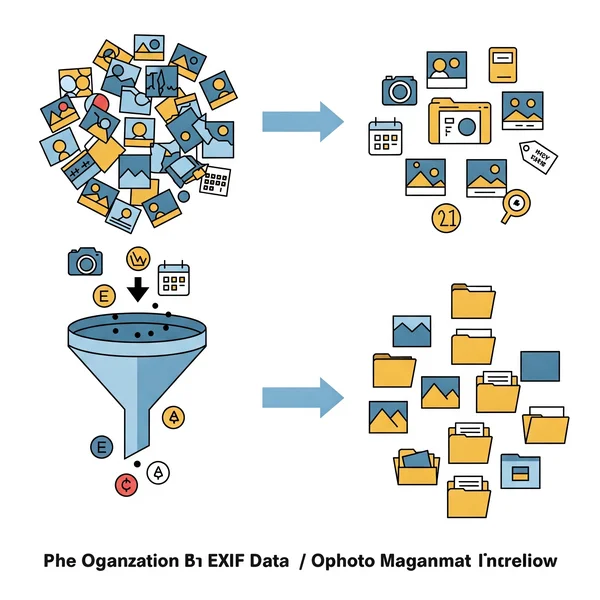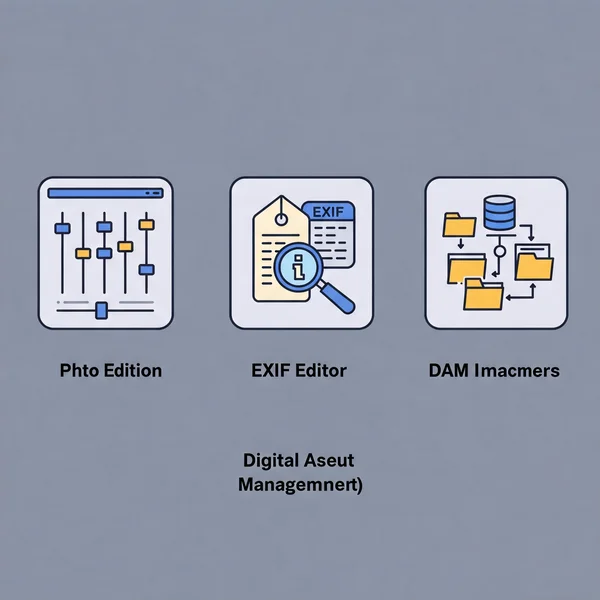EXIF Data for Photographers: Improve Your Workflow
As a photographer, you're constantly juggling shooting, culling, editing, and managing a vast library of images. But what if there was a hidden layer of information in your photos that could significantly improve photography workflow? That's where EXIF data comes in. This article is specifically for photographers looking to leverage metadata management to streamline their processes, enhance photo organization, and bolster their digital asset management. How can EXIF data help me find my best photos quickly? Let's explore. For a suite of tools designed with photographers in mind, check out our EXIF solutions.
Understanding EXIF Data: A Photographer's Perspective
While we've covered the basics of EXIF data before, let's re-examine it through the lens of a working photographer. Effective metadata management starts with knowing what information is most valuable to your photography workflow.
Key EXIF Fields for Photographers
Beyond the standard date and time, photographers should pay close attention to:
- Camera Settings: Shutter speed, aperture, ISO, focal length. Essential for analyzing your shots and replicating successful techniques.
- Lens Information: Helps in identifying which lenses perform best in certain situations or if specific lens corrections are needed.
- GPS Data: Useful for location scouting, remembering shoot locations, and for travel photography.
- Copyright and Author Information: Crucial for copyright protection exif strategies.
- Keywords and Ratings: The backbone of efficient photo organization.
Beyond the Basics: What Deeper Metadata Tells You
Delving deeper, fields like focus mode, metering mode, white balance settings, and even flash information can provide invaluable insights when reviewing your work, helping to refine your shooting style and technical skills. This level of detail is a core part of robust digital asset management.

Leveraging EXIF for Efficient Photo Organization & Culling
One of the biggest time-sinks in any photography workflow is culling and organizing thousands of images. EXIF data is your secret weapon here.
Sorting and Filtering by EXIF Tags
Imagine quickly finding all photos shot with a specific lens, at a particular ISO, or during a certain month. Most photo management software allows you to sort and filter your library based on EXIF data, making photo organization a breeze.
Automating Folder Structures with EXIF Data
Some tools can automatically create and populate folders based on EXIF information, such as YYYY/MM/DD/EventName. This consistent structure is fundamental to good metadata management.
Using Ratings and Color Labels for Culling
Assigning star ratings or color labels (which are often stored as or linked to EXIF/XMP metadata) during your initial review helps you quickly identify keepers, rejects, and images needing further attention. This dramatically speeds up the culling process.
The Role of Keywords in Your Digital Asset Management
Embedding relevant keywords (e.g., client name, project, location, subject matter) into your EXIF/XMP data makes your images searchable, forming a cornerstone of effective digital asset management.

EXIF Data in Post-Processing: Streamlining Your Editing Workflow
EXIF data isn't just for organizing; it actively assists in optimizing your post-processing photography workflow. How can you improve photography workflow with metadata during editing?
Applying Presets Based on Camera/Lens EXIF
Many editing programs allow you to create or apply development presets based on the camera model or lens used, ensuring a consistent starting point for your edits.
Analyzing Shooting Parameters for Consistent Editing
Reviewing the EXIF data (shutter speed, aperture, ISO) of a series of shots helps you understand the shooting conditions and apply consistent adjustments for a cohesive look.
Correcting Lens Distortions Using EXIF Lens Profiles
Modern editing software uses the lens information from EXIF data to automatically apply lens correction profiles, fixing distortion, vignetting, and chromatic aberration.
Syncing Edits Across Similar Shots
If you have multiple photos taken with similar settings (easily identifiable via EXIF), you can edit one and then quickly sync those adjustments across the entire set, a huge time-saver in metadata management.
Copyright Protection and Rights Management with EXIF Data
Protecting your work is paramount. EXIF data plays a vital role in copyright protection exif and overall digital asset management.
Embedding Your Copyright Information
Consistently embed your name, contact details, and copyright notice (e.g., "© [Your Name] [Year]. All Rights Reserved.") into the relevant EXIF fields of every image you produce. This is a fundamental aspect of professional metadata management.
Watermarking vs. EXIF Copyright
Visual watermarks can be cropped or removed. Copyright information embedded in EXIF data is more persistent, though it too can be stripped. Using both provides a layered approach to copyright protection exif.

Proving Ownership with Embedded Metadata
In case of disputes, the presence of your identifying information within the EXIF data can serve as supporting evidence of your authorship.
Tracking Image Usage
While not solely an EXIF function, some digital asset management systems or online image tracking services utilize embedded metadata to help monitor where and how your images are being used online.
Tools and Software for Advanced EXIF Data Management
To truly harness the power of EXIF data for photographers, you need the right tools:
Professional Photo Editing Software (e.g., Lightroom, Capture One)
These are central to most photographers' photography workflow and offer robust metadata management, viewing, and editing capabilities.
Dedicated EXIF Editors and Viewers
For more granular control or specific tasks, tools like ExifTool (command-line) or user-friendly options like those found on our EXIF data platform can be invaluable. These specialized tools often provide deeper access to EXIF data fields.
Digital Asset Management (DAM) Systems
For photographers with extensive archives, dedicated DAM systems offer sophisticated photo organization, searching, and metadata management features, heavily relying on EXIF data.

Future-Proofing Your Archive: The Importance of Consistent Metadata
A well-managed archive is a valuable asset. Establishing a consistent metadata management strategy today, meticulously applying keywords, ratings, and copyright information to your EXIF data, will ensure your work remains accessible, searchable, and protected for years to come. This is a key principle to improve photography workflow in the long term.
Photographers' Top Questions About EXIF Data
How can EXIF data help me find my best photos quickly?
By consistently using ratings, keywords, and color labels (stored in or alongside EXIF), and then filtering by these, along with technical data like lens or aperture, you can rapidly narrow down your search within your photo organization system. This is a core benefit of good metadata management.
Does EXIF data affect my image quality or file size significantly?
No, EXIF data is textual information and typically adds a negligible amount to the overall file size. It does not impact the visual quality of the image.
What's the best way to batch edit EXIF data for client work?
Most professional editing software (Lightroom, Capture One) and some dedicated EXIF data tools allow you to select multiple images and apply or modify EXIF fields (like copyright, keywords, or client name) simultaneously. This is essential for an efficient photography workflow.
Can EXIF data be lost or corrupted? How to prevent it?
Yes, EXIF data can sometimes be stripped by certain software or online platforms if not handled carefully, or rarely, files can become corrupted. To prevent loss:
- Work on copies when using new or untrusted tools.
- Use reputable software for metadata management.
- Maintain regular backups of your image library, including sidecar files (like XMP) if your workflow uses them. You can always view your image's metadata using a reliable online EXIF viewer.
Mastering Metadata for a Smarter Photography Workflow
For the modern photographer, EXIF data is far more than just a list of camera settings; it's a powerful ally in building an efficient, organized, and secure photography workflow. By actively engaging in metadata management – from culling and photo organization to post-processing and copyright protection exif – you unlock significant time savings and gain greater control over your digital asset management. Embrace the power of metadata and transform your craft.